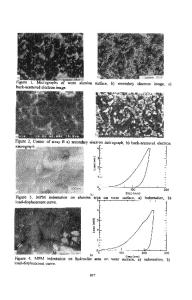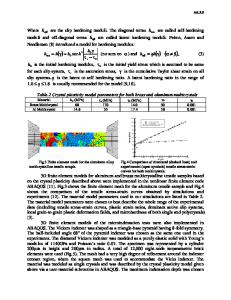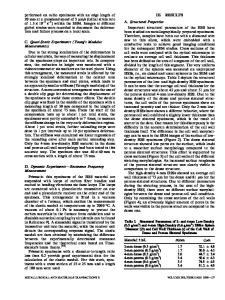Mechanical Properties of Metallic Films on Sapphire
- PDF / 252,251 Bytes
- 5 Pages / 420.48 x 639 pts Page_size
- 91 Downloads / 425 Views
Mat. Res. Soc. Symp. Proc. Vot. 54. 11986 Materials Research Society
806
and coatings [2,3], and it can be used easily at high temperatures in various gaseous environments. The technique depends on standing wave phenomena, and when in longitudinal or torsional resonance, for example, a specimen of length, 1,will contain an integral number, n, of halfwavelengths, x, S: nX -2
(1)
with the wave velocity providing the elastic property data,
V = Xf =-
(2)
=V,
n
p
f is the resonance frequency, M is the elastic modulus, and p is the density. A detailed analysis of the flexural resonance of a film-substrate composite that we will use in the data analysis that follows can be found in ref. 10; Fig. 1 shows a rectangular form of the composite specimen. The specimen is a thin film of thickness 4Son both flat surfaces of a substrate of thickness b; with a specimen in flexural resonance about the long axis, the resonance frequency for the fundamental mode is given by
}
1+I+[3
ff0
(3)
where f0 is the resonance frequency for the uncoated substrate, E2 and El are the Young's moduli for the film and substrate, and P2 and p, are the respective densities.
Fig. 1. Schematic of coated, rectangular specimen. If a film does Two observations can be made from the form of Eq. (3). not adhere to a substrate, its modulus is effectively zero, and Eq. (3) can be regrouped to give f -f Ao
1
P2 26
2
pb
This regrouping illustrates that a measurement of frequency shift for a nonadherent film is proportional to the square root of the mass ratio of
(4)
807
film and substrate, i.e., mflms = (P2 /P 1 )(261b); we shall use this result in evaluating resonance data for gold films on sapphire. The other observation is, of course, that an adherent film will illustrate the modified frequency shift
f-fo
fo
1 3 E2
2
2 26
I
(5)
so that a plot of frequency shift against 6 or against temperature will yield values for the film's dynamic elastic properties; we shall use this result in discussing nickel films on sapphire. With Eqs. (3) through (5) as a basis for the measurements, an experiment is a sequence of steps: (1) measure and record resonance frequencies for the clean substrate over an appropriate range of temperatures; (2) remove and coat the substrate with the film material of interest; and (3) replace the coated substrate in the experimental apparatus and measure the composite resonance behavior over the same range of temperatures. This technique is described in complete detail in ref. 3. EXPERIMENTAL RESULTS AND DISCUSSION We shall present data for two systems that illustrate nonadherent and adherent mechanical behavior, but we wish to emphasize that in both cases these data are accumulated without a destructive test. Gold Data Data are illustrated in Fig. 2 that were obtained for a rectangular sapphire substrate (50.82 x 12.80 x 0.43 mm) both before and after coating 1.0
.6 0
Z .4
.2
0.0
Frquency (Hz)
Fig. 2. Dynamic response of a rectangular sapphire bar at 21.0°C before (o) and after (A) coating with 86.4 nm of gold
Data Loading...











